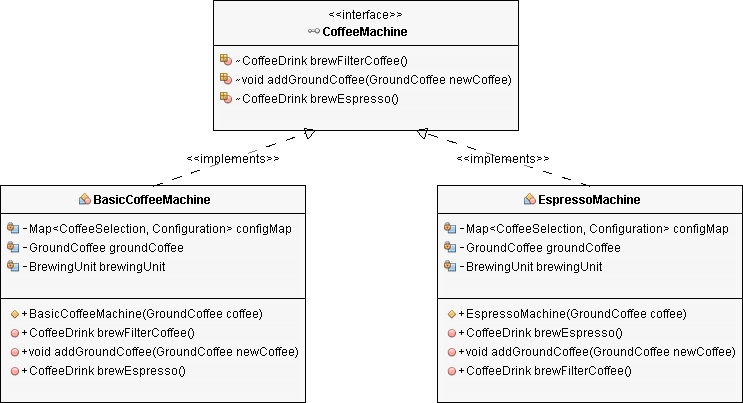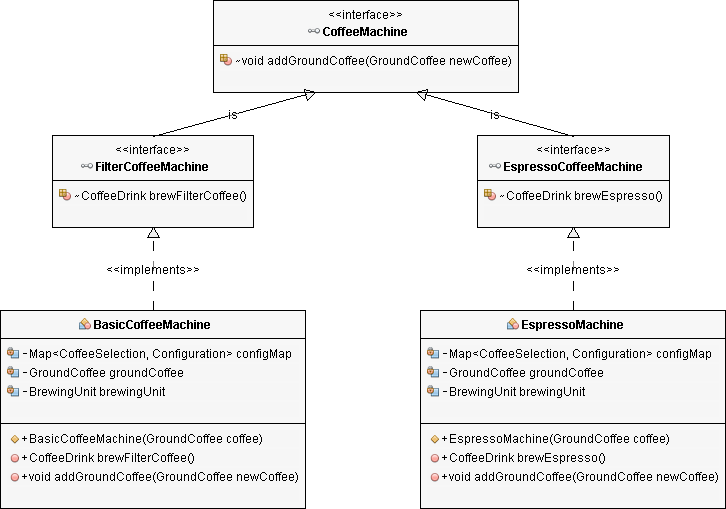SOLID Design Principles Explained: Interface Segregation
This deep dive into Interface Segregation will cover its importance as a SOLID design principle and how to correctly apply it to your code.
Join the DZone community and get the full member experience.
Join For FreeThe Interface Segregation Principle is one of Robert C. Martin’s SOLID design principles. Even though these principles are several years old, they are still as important as they were when he published them for the first time. You might even argue that the microservices architectural style increased their importance because you can apply these principles also to microservices.
Robert C. Martin defined the following five design principles with the goal to build robust and maintainable software:
- Single Responsibility Principle
- OOpen/Closed Principle
- Liskov Substitution Principle
- Interface Segregation Principle
- Dependency Inversion
I already explained the Single Responsibility Principle, the Open/Closed Principle, and the Liskov Substitution Principle in previous articles. So let’s focus on the Interface Segregation Principle.
Definition of the Interface Segregation Principle
The Interface Segregation Principle was defined by Robert C. Martin while consulting for Xerox to help them build the software for their new printer systems. He defined it as:
“Clients should not be forced to depend upon interfaces that they do not use.”
Sounds obvious, doesn’t it? Well, as I will show you in this article, it’s pretty easy to violate this interface, especially if your software evolves and you have to add more and more features. But more about that later.
Similar to the Single Responsibility Principle, the goal of the Interface Segregation Principle is to reduce the side effects and frequency of required changes by splitting the software into multiple, independent parts.
As I will show you in the following example, this is only achievable if you define your interfaces so that they fit a specific client or task.
Violating the Interface Segregation Principle
None of us willingly ignores common design principles to write bad software. But it happens quite often that an application gets used for multiple years and that its users regularly request new features.
From a business point of view, this is a great situation. But from a technical point of view, the implementation of each change bears a risk. It’s tempting to add a new method to an existing interface even though it implements a different responsibility and would be better separated in a new interface. That’s often the beginning of interface pollution, which sooner or later leads to bloated interfaces that contain methods implementing several responsibilities.
Let’s take a look at a simple example where this happened.
In the beginning, the project used the BasicCoffeeMachine class to model a basic coffee machine. It uses ground coffee to brew a delicious filter coffee.
class BasicCoffeeMachine implements CoffeeMachine {
private Map<CoffeeSelection, Configuration> configMap;
private GroundCoffee groundCoffee;
private BrewingUnit brewingUnit;
public BasicCoffeeMachine(GroundCoffee coffee) {
this.groundCoffee = coffee;
this.brewingUnit = new BrewingUnit();
this.configMap = new HashMap<>();
this.configMap.put(CoffeeSelection.FILTER_COFFEE, new Configuration(30, 480));
}
@Override
public CoffeeDrink brewFilterCoffee() {
Configuration config = configMap.get(CoffeeSelection.FILTER_COFFEE);
// brew a filter coffee
return this.brewingUnit.brew(CoffeeSelection.FILTER_COFFEE, this.groundCoffee, config.getQuantityWater());
}
@Override
public void addGroundCoffee(GroundCoffee newCoffee) throws CoffeeException {
if (this.groundCoffee != null) {
if (this.groundCoffee.getName().equals(newCoffee.getName())) {
this.groundCoffee.setQuantity(this.groundCoffee.getQuantity() + newCoffee.getQuantity());
} else {
throw new CoffeeException("Only one kind of coffee supported for each CoffeeSelection.");
}
} else {
this.groundCoffee = newCoffee;
}
}
}At that time, it was perfectly fine to extract the CoffeeMachine interface with the methods addGroundCoffee and brewFilterCoffee. These are the two essential methods of a coffee machine and should be implemented by all future coffee machines.
public interface CoffeeMachine {
CoffeeDrink brewFilterCoffee() throws CoffeeException;
void addGroundCoffee(GroundCoffee newCoffee) throws CoffeeException;
}Polluting the Interface With a New Method
But then somebody decided that the application also needs to support espresso machines. The development team modeled it as the EspressoMachine class that you can see in the following code snippet. It’s pretty similar to the BasicCoffeeMachine class.
public class EspressoMachine implements CoffeeMachine {
private Map configMap;
private GroundCoffee groundCoffee;
private BrewingUnit brewingUnit;
public EspressoMachine(GroundCoffee coffee) {
this.groundCoffee = coffee;
this.brewingUnit = new BrewingUnit();
this.configMap = new HashMap();
this.configMap.put(CoffeeSelection.ESPRESSO, new Configuration(8, 28));
}
@Override
public CoffeeDrink brewEspresso() {
Configuration config = configMap.get(CoffeeSelection.ESPRESSO);
// brew a filter coffee
return this.brewingUnit.brew(CoffeeSelection.ESPRESSO,
this.groundCoffee, config.getQuantityWater());
}
@Override
public void addGroundCoffee(GroundCoffee newCoffee) throws CoffeeException {
if (this.groundCoffee != null) {
if (this.groundCoffee.getName().equals(newCoffee.getName())) {
this.groundCoffee.setQuantity(this.groundCoffee.getQuantity()
+ newCoffee.getQuantity());
} else {
throw new CoffeeException(
"Only one kind of coffee supported for each CoffeeSelection.");
}
} else {
this.groundCoffee = newCoffee;
}
}
@Override
public CoffeeDrink brewFilterCoffee() throws CoffeeException {
throw new CoffeeException("This machine only brew espresso.");
}
}The developer decided that an espresso machine is just a different kind of coffee machine. So, it has to implement the CoffeeMachine interface.
The only difference is the brewEspresso method, which the EspressoMachine class implements instead of the brewFilterCoffee method. Let’s ignore the Interface Segregation Principle for now and perform the following three changes:
1. The EspressoMachine class implements the CoffeeMachine interface and its brewFilterCoffee method.
public CoffeeDrink brewFilterCoffee() throws CoffeeException {
throw new CoffeeException("This machine only brews espresso.");
}2. We add the brewEspresso method to the CoffeeMachine interface so that the interface allows you to brew an espresso.
public interface CoffeeMachine {
CoffeeDrink brewFilterCoffee() throws CoffeeException;
void addGroundCoffee(GroundCoffee newCoffee) throws CoffeeException;
CoffeeDrink brewEspresso() throws CoffeeException;
}3. You need to implement the brewEspresso method on the BasicCoffeeMachine class because it’s defined by the CoffeeMachine interface. You can also provide the same implementation as a default method on the CoffeeMachine interface.
@Override
public CoffeeDrink brewEspresso() throws CoffeeException {
throw new CoffeeException("This machine only brews filter coffee.");
}After you’ve done these changes, your class diagram should look like this:

Especially the 2nd and 3rd change should show you that the CoffeeMachine interface is not a good fit for these two coffee machines. The brewEspresso method of the BasicCoffeeMachine class and the brewFilterCoffee method of the EspressoMachine class throw a CoffeeException because these operations are not supported by these kinds of machines. You only had to implement them because they are required by the CoffeeMachine interface.
But the implementation of these two methods isn’t the real issue. The problem is that the CoffeeMachine interface will change if the signature of the brewFilterCoffee method of the BasicCoffeeMachine method changes. That will also require a change in the EspressoMachine class and all other classes that use the EspressoMachine, even so, the brewFilterCoffee method doesn’t provide any functionality and they don’t call it.
Follow the Interface Segregation Principle
OK, so how can you fix the CoffeMachine interface and its implementations BasicCoffeeMachine and EspressoMachine?
You need to split the CoffeeMachine interface into multiple interfaces for the different kinds of coffee machines. All known implementations of the interface implement the addGroundCoffee method. So, there is no reason to remove it.
public interface CoffeeMachine {
void addGroundCoffee(GroundCoffee newCoffee) throws CoffeeException;
}That’s not the case for the brewFilterCoffee and brewEspresso methods. You should create two new interfaces to segregate them from each other. And in this example, these two interfaces should also extend the CoffeeMachine interface. But that doesn’t have to be the case if you refactor your own application. Please check carefully if an interface hierarchy is the right approach, or if you should define a set of interfaces.
After you’ve done that, the FilterCoffeeMachine interface extends the CoffeeMachine interface, and defines the brewFilterCoffee method.
public interface FilterCoffeeMachine extends CoffeeMachine {
CoffeeDrink brewFilterCoffee() throws CoffeeException;
}And the EspressoCoffeeMachine interface also extends the CoffeeMachine interface, and defines the brewEspresso method.
public interface EspressoCoffeeMachine extends CoffeeMachine {
CoffeeDrink brewEspresso() throws CoffeeException;
}Congratulation, you segregated the interfaces so that the functionalities of the different coffee machines are independent of each other. As a result, the BasicCoffeeMachine and the EspressoMachine class no longer need to provide empty method implementations and are independent of each other.

The BasicCoffeeMachine class now implements the FilterCoffeeMachine interface, which only defines the addGroundCoffee and the brewFilterCoffee methods.
public class BasicCoffeeMachine implements FilterCoffeeMachine {
private Map<CoffeeSelection, Configuration> configMap;
private GroundCoffee groundCoffee;
private BrewingUnit brewingUnit;
public BasicCoffeeMachine(GroundCoffee coffee) {
this.groundCoffee = coffee;
this.brewingUnit = new BrewingUnit();
this.configMap = new HashMap<>();
this.configMap.put(CoffeeSelection.FILTER_COFFEE, new Configuration(30,
480));
}
@Override
public CoffeeDrink brewFilterCoffee() {
Configuration config = configMap.get(CoffeeSelection.FILTER_COFFEE);
// brew a filter coffee
return this.brewingUnit.brew(CoffeeSelection.FILTER_COFFEE,
this.groundCoffee, config.getQuantityWater());
}
@Override
public void addGroundCoffee(GroundCoffee newCoffee) throws CoffeeException {
if (this.groundCoffee != null) {
if (this.groundCoffee.getName().equals(newCoffee.getName())) {
this.groundCoffee.setQuantity(this.groundCoffee.getQuantity()
+ newCoffee.getQuantity());
} else {
throw new CoffeeException(
"Only one kind of coffee supported for each CoffeeSelection.");
}
} else {
this.groundCoffee = newCoffee;
}
}
}And the EspressoMachine class implements the EspressoCoffeeMachine interface with its methods addGroundCoffee and brewEspresso.
public class EspressoMachine implements EspressoCoffeeMachine {
private Map configMap;
private GroundCoffee groundCoffee;
private BrewingUnit brewingUnit;
public EspressoMachine(GroundCoffee coffee) {
this.groundCoffee = coffee;
this.brewingUnit = new BrewingUnit();
this.configMap = new HashMap();
this.configMap.put(CoffeeSelection.ESPRESSO, new Configuration(8, 28));
}
@Override
public CoffeeDrink brewEspresso() throws CoffeeException {
Configuration config = configMap.get(CoffeeSelection.ESPRESSO);
// brew a filter coffee
return this.brewingUnit.brew(CoffeeSelection.ESPRESSO,
this.groundCoffee, config.getQuantityWater());
}
@Override
public void addGroundCoffee(GroundCoffee newCoffee) throws CoffeeException {
if (this.groundCoffee != null) {
if (this.groundCoffee.getName().equals(newCoffee.getName())) {
this.groundCoffee.setQuantity(this.groundCoffee.getQuantity()
+ newCoffee.getQuantity());
} else {
throw new CoffeeException(
"Only one kind of coffee supported for each CoffeeSelection.");
}
} else {
this.groundCoffee = newCoffee;
}
}
}Extending the Application
After you segregated the interfaces so that you can evolve the two coffee machine implementations independently of each other, you might be wondering how you can add different kinds of coffee machines to your applications. In general, there are four options for that:
- The new coffee machine is a FilterCoffeeMachine or an EspressoCoffeeMachine. In this case, you only need to implement the corresponding interface.
- The new coffee machine brews filter coffee and espresso. This situation is similar to the first one. The only difference is that your class now implements both interfaces; the FilterCoffeeMachine and the EspressoCoffeeMachine.
- The new coffee machine is completely different to the other two. Maybe it’s one of these pad machines that you can also use to make tea or other hot drinks. In this case, you need to create a new interface and decide if you want to extend the CoffeeMachine interface. In the example of the pad machine, you shouldn’t do that because you can’t add ground coffee to a pad machine. So, your PadMachine class shouldn’t need to implement an addGroundCoffee method.
- The new coffee machine provides new functionality, but you can also use it to brew a filter coffee or an espresso. In that case, you should define a new interface for the new functionality. Your implementation class can then implement this new interface and one or more of the existing interfaces. But please make sure to segregate the new interface from the existing ones, as you did for the FilterCoffeeMachine and the EspressoCoffeeMachine interfaces.
Summary
The SOLID design principles help you to implement robust and maintainable applications. In this article, we took a detailed look at the Interface Segregation Principle which Robert C. Martin defined as:
“Clients should not be forced to depend upon interfaces that they do not use.”
By following this principle, you prevent bloated interfaces that define methods for multiple responsibilities. As explained in the Single Responsibility Principle, you should avoid classes and interfaces with multiple responsibilities because they change often and make your software hard to maintain.
That’s all about the Interface Segregation Principle. If you want to dive deeper into the SOLID design principles, please take a look at my other articles in this series:
- Single Responsibility Principle
- Open/Closed Principle
- Liskov Substitution Principle
- Interface Segregation Principle
- Dependency Inversion
Published at DZone with permission of Thorben Janssen, DZone MVB. See the original article here.
Opinions expressed by DZone contributors are their own.

Comments